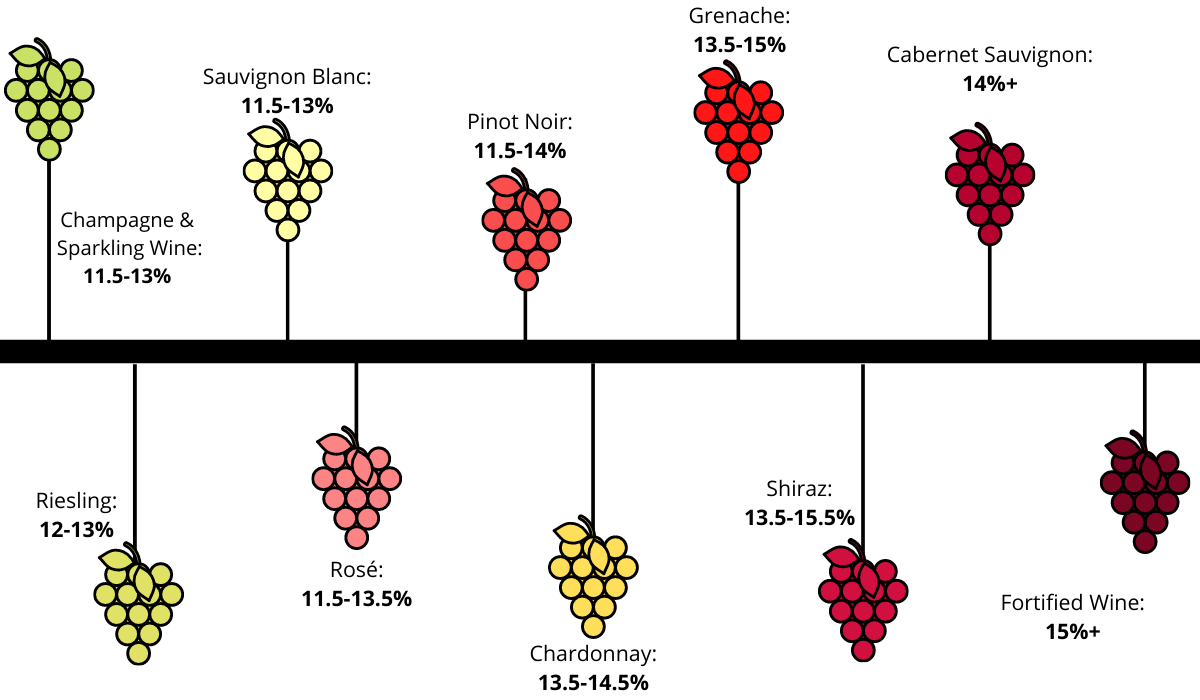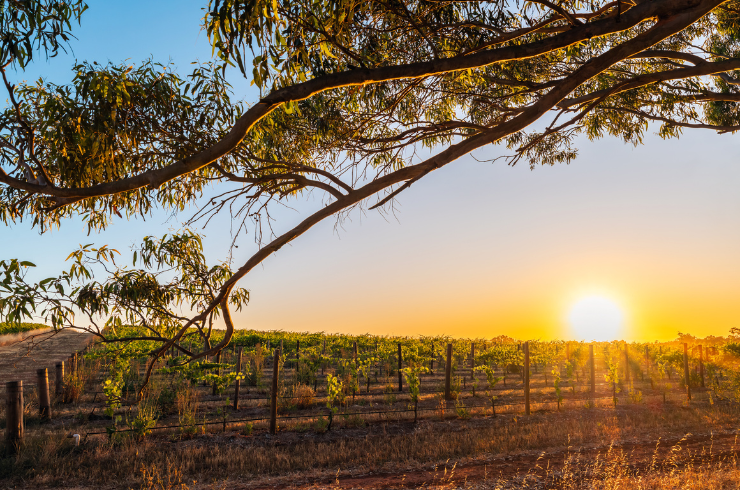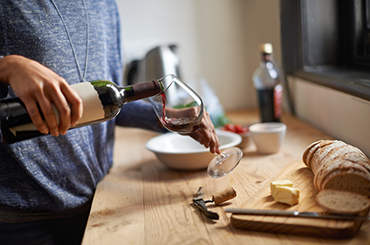While the process is complex, simply put, alcoholic fermentation transforms grapes into wine. In white winemaking, grapes are picked, crushed and pressed prior to fermentation, while for red wine, grapes are typically pressed afterwards to extract tannin and colour. During fermentation, yeasts convert sugars into alcohol and carbon dioxide.
Many factors can affect the alcohol content of a wine, including climate, growing conditions, grape variety and even temperature during fermentation. Ripe fruit contains more sugars and produces more alcohol in the fermentation process, which makes picking times a crucial winemaking decision. Earlier-harvested fruit can result in lighter wines higher in acid, and late harvesting in luscious, higher-in-alcohol styles.
 Red wine grapes undergoing fermentation. Credit: Wine Australia
Red wine grapes undergoing fermentation. Credit: Wine Australia
The hallmarks of an excellent, ageworthy wine are complexity, acidity and – in red wine – tannin. While some of these traits may coincide with wines of higher alcohol content, the presence of alcohol itself doesn’t necessarily indicate quality. In fact, sometimes, it can mean the opposite.
The alcohol content of an ageing wine will remain the same from the time fermentation is complete. In a poor or fair example, ageing may cause other flavour characteristics to fade and the presence of alcohol to become overbearing and unpleasant.
The correct alcohol percentage for wine is relative to what is typical of the variety – and in Australia, what is stated on the bottle can vary by up to 1.5%.
Here are the alcohol content ranges for some popular varieties in Australia.

Where a wine sits on the spectrum may influence its taste and food-pairing potential. Here are three easy ways to tell how much alcohol is in a wine.
Read: The alcohol content of a wine is printed on the label and can range from about 11 per cent to 15 per cent and higher, depending on the style. This percentage refers to ABV or alcohol by volume – a standardised measurement used globally to denote how much alcohol is in a beverage.
Look: If you don’t have the bottle, you can get a good idea of how much alcohol is in a glass of wine just by looking at it. That common term of “wine legs” or “wine tears” refers to the droplets that form on the inside of the glass when swirled. This phenomenon is known as the Gibbs-Marangoni Effect and occurs due to fluid surface tension caused by the evaporation of alcohol. The higher in alcohol the wine, the more “tears” or “legs” will form.
Taste: When it comes to tasting wine, there are two descriptors typically used to indicate alcohol content: “body” and “heat”. Alcohol can feel hot on the palate – much like that burning sensation you get after a sip of straight spirit – and a wine that feels “hot” after swallowing most likely has a high alcohol content. Alcohol also contributes to the body and texture of a wine. When tasting, pay attention to how heavy the liquid feels across your palate – alcohol is more viscous than water, so a wine with a higher ABV will have a distinctly heavier mouthfeel.
Alcohol percentage in wine
Many factors can affect the alcohol content of a wine, including climate, growing conditions, grape variety and even temperature during fermentation. Ripe fruit contains more sugars and produces more alcohol in the fermentation process, which makes picking times a crucial winemaking decision. Earlier-harvested fruit can result in lighter wines higher in acid, and late harvesting in luscious, higher-in-alcohol styles.
 Red wine grapes undergoing fermentation. Credit: Wine Australia
Red wine grapes undergoing fermentation. Credit: Wine Australia Does more alcohol mean better wine?
The hallmarks of an excellent, ageworthy wine are complexity, acidity and – in red wine – tannin. While some of these traits may coincide with wines of higher alcohol content, the presence of alcohol itself doesn’t necessarily indicate quality. In fact, sometimes, it can mean the opposite.
The alcohol content of an ageing wine will remain the same from the time fermentation is complete. In a poor or fair example, ageing may cause other flavour characteristics to fade and the presence of alcohol to become overbearing and unpleasant.
How much alcohol should wine have?
The correct alcohol percentage for wine is relative to what is typical of the variety – and in Australia, what is stated on the bottle can vary by up to 1.5%.
Here are the alcohol content ranges for some popular varieties in Australia.

Where a wine sits on the spectrum may influence its taste and food-pairing potential. Here are three easy ways to tell how much alcohol is in a wine.
Read: The alcohol content of a wine is printed on the label and can range from about 11 per cent to 15 per cent and higher, depending on the style. This percentage refers to ABV or alcohol by volume – a standardised measurement used globally to denote how much alcohol is in a beverage.
Look: If you don’t have the bottle, you can get a good idea of how much alcohol is in a glass of wine just by looking at it. That common term of “wine legs” or “wine tears” refers to the droplets that form on the inside of the glass when swirled. This phenomenon is known as the Gibbs-Marangoni Effect and occurs due to fluid surface tension caused by the evaporation of alcohol. The higher in alcohol the wine, the more “tears” or “legs” will form.
Taste: When it comes to tasting wine, there are two descriptors typically used to indicate alcohol content: “body” and “heat”. Alcohol can feel hot on the palate – much like that burning sensation you get after a sip of straight spirit – and a wine that feels “hot” after swallowing most likely has a high alcohol content. Alcohol also contributes to the body and texture of a wine. When tasting, pay attention to how heavy the liquid feels across your palate – alcohol is more viscous than water, so a wine with a higher ABV will have a distinctly heavier mouthfeel.
For more information on tasting, cellaring, storing wine and much more – visit the Wine Companion resources hub.
Have you joined our wine club? Get started today!
Latest Articles
-
Win
Win a stunning collection of Plumm glassware and wine, valued at over $500
1 day ago -
Wine Lists
Top Christmas wines under $30 (and five worth splurging on)
2 days ago -
Wine Lists
Why you should drink Australian this festive season (and 80 of our best wines to try)
2 days ago -
From the tasting team
The Aussie wines the Halliday Tasting Team will be opening this festive season
2 days ago






